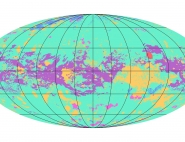Two boundary layers in Titan's lower troposphere inferred from a climate model
Saturn's moon Titan has a dense atmosphere, but its thermal structure is poorly known. Conflicting information has been gathered on the nature, extent and evolution of Titan's planetary boundary layer-the layer of the atmosphere that is influenced by the surface-from radio-occultation observations by the Voyager 1 spacecraft and the Cassini orbiter, measurements by the Huygens probe and by dune-spacing analyses. Specifically, initial analyses of the Huygens data suggested a boundary layer of 300 m depth with no diurnal evolution, incompatible with alternative estimates of 2-3 km. Here we use a three-dimensional general circulation model, albeit not explicitly simulating the methane cycle, to analyse the dynamics leading to the thermal profile of Titan's lowermost atmosphere. In our simulations, a convective boundary layer develops in the course of the day, rising to an altitude of 800 m. In addition, a seasonal boundary of 2 km depth is produced by the reversal of the Hadley cell at the equinox, with a dramatic impact on atmospheric circulation. We interpret fog that had been discovered at Titan's south pole earlier as boundary layer clouds. We conclude that Titan's troposphere is well structured, featuring two boundary layers that control wind patterns, dune spacing and cloud formation at low altitudes.
Published in Nature Geoscience 5, 106-109 (january 2012) doi:10.1038/ngeo1374
See an interview about it (in French).


